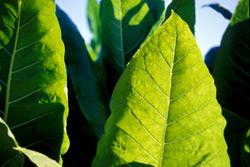Russ Ouellette
 I don’t even know where to begin writing about nicotine.
I don’t even know where to begin writing about nicotine.
If there is any substance that has a more “Jekyll and Hyde” profile than nicotine, I’m not aware of it. It can be a stimulant or a calmative. It can be a deadly poison, or it can be therapeutic. It can aid in spurts of energy and lead to periods of lethargy. Finally, most people know little about the substance, including their own intake, but I digress (as I am frequently wont to do).
Let’s start with the basics- nicotine is an alkaloid, and in highly concentrated doses is a strong poison. The amount taken in during smoking is nowhere near what would be necessary for toxicity, and under all but the most unusual circumstances (such as wearing a number of transdermal patches and chain-smoking cigarettes simultaneously) will rarely cause severe illness or death. It also is a vasoconstrictor, so it can elevate blood pressure and can affect many bodily systems.
 One thing that is rarely discussed, however, is that most people routinely take in some level of nicotine, whether they use tobacco or not. Nicotine is present in the members of the nightshade family, of which tobacco is one. But that family also includes potatoes, tomatoes, eggplants and peppers. So, many of the people who warn others about the harmful effects of nicotine are getting some in their diet regularly. Granted, the level in these foods is comparatively low versus using chew or dip, but it’s there, nonetheless.
One thing that is rarely discussed, however, is that most people routinely take in some level of nicotine, whether they use tobacco or not. Nicotine is present in the members of the nightshade family, of which tobacco is one. But that family also includes potatoes, tomatoes, eggplants and peppers. So, many of the people who warn others about the harmful effects of nicotine are getting some in their diet regularly. Granted, the level in these foods is comparatively low versus using chew or dip, but it’s there, nonetheless.
Nicotine is a biphasic substance, meaning that in low doses, it has a stimulant effect, but in larger doses, it can have a calming or soporific influence. Short puffs on a cigarette, or smoking cigars or pipes (without inhaling), delivers such low doses. The stimulation caused by nicotine is not just a psychological effect, either. Testing has shown that attention, memory and cognitive ability can be measurably increased under the influence of nicotine. In the case of cigars and pipes, the delivery is much slower as well, due to less absorption from the mucus membranes of the mouth as opposed to the large surface area of the lungs. It takes 15 to 20 minutes for the nicotine in pipe or tobacco smoke to break the blood/brain barrier, whereas it takes less than 10 seconds to do so for a cigarette smoker. When a cigarette smoker inhales deeply, or when a pipe smoker encounters a Lakeland flake or rope with dark-fired, the higher level of vitamin N can cause relaxation or even drowsiness.
Nicotine is a nitrogenous substance, and so tobacco grown in soil with a high nitrogen content, or in a field where nitrogen fertilizers are used, can be a bit more potent. Much of what we identify as “spice” in a cigar or pipe blend comes from the influence of nicotine. That sense of a “bite” in the back of the throat also comes from this source. To some degree, nicotine has some impact on the heat of peppers.
It was also used extensively in the past as a very effective pesticide, but due to its toxicity to mammals through ingestion and skin contact, it is largely avoided today, however, there are still uses for nicotine. Of course, it’s used as the base for many smoking cessation products. It can also have anti-inflammatory properties (like capsicum, which is also found in hot peppers…
coincidence?), has been shown to have cancer-preventing properties under certain circumstances, and has been involved in testing as a treatment for Alzheimer’s and Parkinson’s diseases. It may also have a therapeutic effect for people with depression or ADHD.
 There are some other aspects of nicotine that are intriguing. The use of it has been tied to regularity with some people. In fact, some folks who have quit smoking abruptly have had bouts of gastric distress, bloating and other gastrointestinal issues.
There are some other aspects of nicotine that are intriguing. The use of it has been tied to regularity with some people. In fact, some folks who have quit smoking abruptly have had bouts of gastric distress, bloating and other gastrointestinal issues.
One of the impacts it has on the body is that it causes the liver to release glucose into the bloodstream, so the blood sugar level will rise. In the case of higher amounts due to stronger tobacco or using it orally, nasally or through inhalation, the blood glucose level can rise quickly and then crash, leaving the person nauseous, shaky, disoriented and may even cause short, rapid hiccups, also known as the “nic-hics”. For this reason, if you’re planning on trying a stronger pipe tobacco or cigar, keeping a piece of candy nearby is a good idea. Chocolate works very well, as it not only has the sugar that your body wants, but it has some caffeine as well to expedite the delivery of the glucose.
One of the commonly-held fallacies is that nicotine is a carcinogen. This is not the case. In fact, in the case of HIV-positive people, it has been shown to possibly retard the development of a cancer that often affects that group.
The vasoconstrictor impact, and the fact that nicotine can elevate the heart rate are the main reasons that people with cardiac problems are encouraged to avoid it. Of course, the degree of the effect has a lot to do with what form the tobacco is used in, how it’s processed and the natural nicotine content of the particular strain(s) used. For the most part, Virginias (flue-cured) tend to be rather low in nicotine, with Burleys (air and fire-cured) being significantly higher, and sun-cured Oriental/Turkish leaf falling somewhere in-between. Use of heat in processing can reduce the amount of nicotine, whereas other processes can increase it.
My purpose isn’t to promote nicotine or to bash it. It’s in a number of commonly-ingested foods, and therefore can’t be a catastrophic influence on one’s health in measured amounts. As in just about everything in life, moderation seems to be the key; after all, moderation is often the difference between use and abuse. All I know for sure is that the measured use of tobacco has helped me remain clear when tired, on occasion, and helped me to relax often, and that may be more important to my overall well-being.
|
Russ Ouellette is the blender/creator of the Hearth & Home series of tobaccos for Habana Premium Cigar Shoppe and www.pipesandcigars.com in Bethlehem, PA. He has been a pipe smoker and blender for over 30 years, and enjoys feedback from the pipe smoking public. You can reach Russ at russo@pipesandcigars.com or by calling 1-800-494-9144 on Monday, Wednesday and Thursday from 9 am to 5 pm and Friday from 1 pm to 5 pm. |

















Super informative! Thanks for the info. I always knew potatoes to be exceptionally calming. haha.
Russ
Thanks very much for posting that article. I was not aware that nicotine was found in common foods.
Interesting about raising blood sugar; being insulin dependent diabetic, I just haven’t noticed it. Maybe I should check to see.
Very interesting. To add a point, I recall studying in college, in a health and wellness class none the less, that nicotine has been known to help those with chronic pain issues. Studies have shown those who had issues with nerve pain or deep tissue pain noticed a significant decrease in pain levels during and after smoking a cigar or pipe. Cigarettes had a similar effect, but to a lesser degree, possibly due to the different stands as you mentioned.
Just thought I’d share some useless info I have accumulated over the years and this seemed to be a good venue. Thank you again for the article.
Good memory. Nicotine also affects dopamine levels beside having an anti-inflammatory effect, so the conjecture is that the combination of the two will help with pain, especially muscular and joint issues. Unfortunately, it has no affect on the pain you feel when writing checks for the monthly bills.
Russ
Yes that’s too bad. The only medicine I know for that pain comes in the single malt variety. Even that is just a temporary effect, though in higher doses it can cause memory loss;so there’s always that.
-Brian
Thanks for this very scholarly and thorough analysis of nicotine and its biological effects. My question is a little off-topic but it’s one I’m sure you have thought about.
Simple paper chromatography of even the “purest” VA liquid ends up looking like the sky at night, there are so many compounds. Could agents other than nicotine itself therefore be responsible, in large part, for the widely discussed soporific/intoxicating qualities of pipe tobaccos, especially the dark-cured ones?
There certainly could be other compounds that have an impact on the calmative influence of pipe or cigar smoking, but the studies that I looked at seemed to have focused upon nicotine, so I assume that they may have used patches or gum during the research phase. That said, some synergistic relationship between multiple compounds might amplify the effect for pipe smokers.
Russ
Thanks Russ. If they did as you say, it is entirely reasonable to conclude that the main effects are due to nicotine itself.
Great article.
Thanks Russ, great article
Mike
Fantastic article Russ.
Also thank you so much for making so many great Hearth & Home blends. I don’t know what I would do without them.
“As in just about everything in life, moderation seems to be the key; after all, moderation is often the difference between use and abuse. All I know for sure is that the measured use of tobacco has helped me remain clear when tired, on occasion, and helped me to relax often, and that may be more important to my overall well-being.”
Very well-stated. There continue to be threads on the “Brothers of Briar” forum about pipe smoking and addiction. I’m not sure about the origin of the phrase “moderation is often the difference between use and abuse,” but that pithiness contains volumes of wisdom. For me addiction has everything to do with purposeful distraction, like pipe smoking, so that underlying aversive issues can be avoided. But through what I feel is denial many pipe smokers regard it as a hobby, like playing checkers! I diverge markedly at this point as nicotine is a drug that insists on having some amount of it in the body or else, the else as withdrawal, a craving to re-ingest, i.e. “the fix.” The drugging action of nicotine sets up craving on both the physiological and psychological planes, while “checkers withdrawal” lacks the physiological.
It is this difference that signals addiction, to my way of thinking. Addictive yearnings are obsessive and not easily ignored. But, returning to Mr. Ouellette’s remark on moderate use and the relaxation it effects, which began this comment, I think we get to the heart of what pipe smoking can be, a manageable pleasure that can be used positively and is best enjoyed in measured doses.
Excellent article. On a slightly different note, why is it that the powers that be are so vehemently against smoking? Why are alcohol commercials allowed, but not tobacco commercials? My theory is that most people in power do not smoke/used to, but quit. And it’s a fact, at least in my experience, that ex-smokers tend to take an extremist anti-smoking view that they waste absolutely no time in trying to impose on those of us who do smoke. But like I said, it’s just a theory. Doesn’t keep me up at night. Cheers, all you Kapnismologists out there!
Reading the post by norrland, I was reminded of a remark made by a Senator during the Reagan administration when Casper Weinberger (Secretary of Defense) was pushing the “smoke free” agenda in the armed forces. He said “I hope he doesn’t give up sex!”. Also, a historical quote (I don’t know how accurate it is) – “There’s nothing worse than a reformed whore”. There really is nothing worse than a reformed smoker, drinker, etc.
Thanks for the article Russ. I was unaware that some common vegetables contained nicotine. I Googled “food with nicotine” and found many articles supporting the observation. No wonder I like eggplant!
I should have responded to this long ago- did Russ say tobacco was therapeutic? I found out over a decade ago that nasal snuff could often ward off sneezing attacks due to my allergies. Put that in your pipe and smoke it!